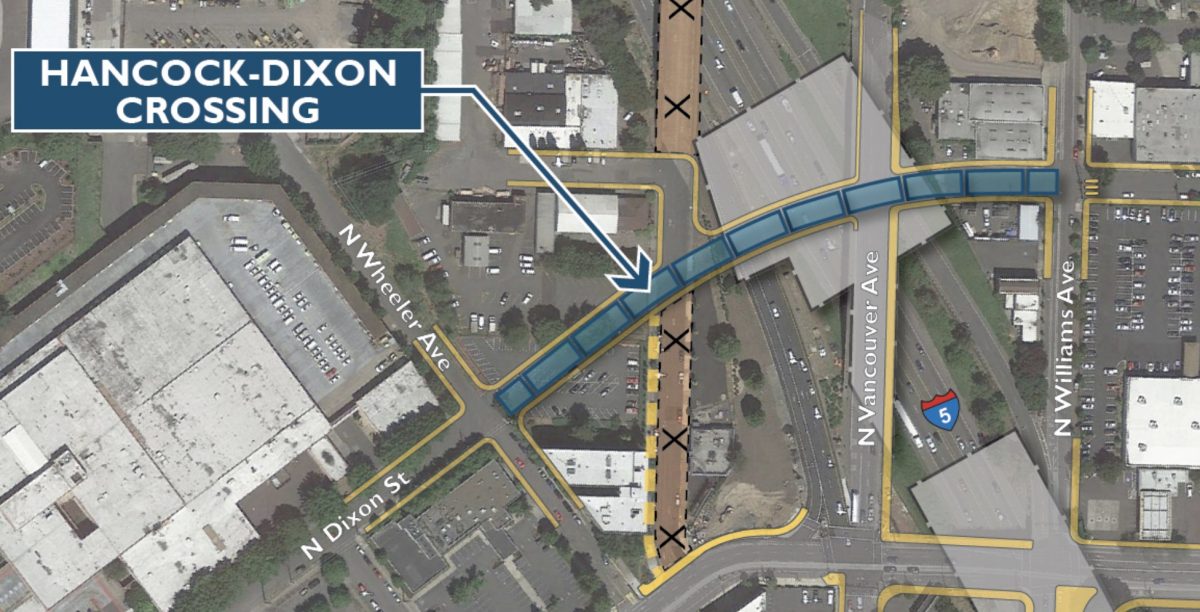One of the main points the Oregon Department of Transportation is using to sell their I-5 Rose Quarter project is that it will vastly improve cycling and walking conditions on the surface streets above the freeway.
Turns out that’s not exactly the case. The two official committees that advise the City of Portland on cycling and walking strongly oppose the project and recommend a “No Build”.
The position of the Portland Bureau of Transportation’s Bicycle Advisory Committee (BAC) and the PBOT Pedestrian Advisory Committee (PAC) should raise major red flags about the credibility of ODOT’s claims about this project.
In their March 22nd letter (PDF) to PBOT Commissioner Chloe Eudaly and ODOT Project Manager Megan Channell, BAC Chair Rithy Khut and Vice-Chair Elliot Akwai-Scott outline many major concerns about the proposed cycling infrastructure design and about ODOT’s handling of the project in general.
The BAC says they haven’t had enough time to provide meaningful feedback because of ODOT’s, “obfuscation and delay in providing information” and they have requested that a full Environmental Impact Statement (EIS) be prepared. Even with what they feel is limited information, the BAC has decided that, “the Build Alternative would fail to achieve the stated project goals and objectives, especially in critical areas related to bicycling, but also including the resulting conditions for walking and transit, local connectivity, safety, equity, and climate outcomes. This is in direct conflict with city and state planning goals.”
To put a finer point on it, the letter states: “The proposed bicycle facilities in the I-5 Rose Quarter project fail to provide meaningful safety improvements, improve travel times for bicyclists, or encourage the desired city-wide bicycle mode splits.”
Specifically, the BAC calls out the fact that ODOT’s proposal would mostly rebuild bikeways where they already exist — and it would remove the Flint Bridge which currently provides a direct connection that’s used by about 3,000 bicycle riders a day. The BAC says the negative impacts of losing Flint won’t be replaced by any of the proposed facilities. Another big concern is the fact that construction-related delays would have a significant negative impact on the approximately 8,000 bicycle users who travel through the project area every day. “After five years of construction,” the letter states, “the Build Alternative would not offer compelling or substantial improvements for bicycling.”
ODOT’s cycling pitch focuses on two new crossings: One at Hancock/Dixon and the other at Clackamas. The BAC pans the Hancock/Dixon crossing because it won’t include physically separated cycling facilities and it would include, “a permanently inaccessible 10% grade.” For perspective, that’s about the same as the steepest sections of Mt. Tabor. North Williams Avenue currently has about a 1.5 percent grade from the Rose Quarter heading north. The steepest part of the N Mississippi Avenue Hill is 6.5 percent. As for the Clackamas bridge, it would be carfree, but it doesn’t support any existing travel demands, the BAC says.

Thanks for reading BikePortland.
Please consider a $10/month subscription or a one-time payment
to help maintain and expand this vital community resource.
In general, the BAC says ODOT’s surface street proposals clearly put the needs of auto users above the needs of people bicycling and walking. Increased travel times for cycling (and transit too) and unsafe infrastructure with wide corner radii and unsafe transitions between two-way and one-way facilities.
That increased travel time flies directly in the face of Portland’s adopted Transportation System Plan (TSP), which states that major bikeways, “should be designed to… minimize delays by emphasizing the movement of bicycles.”
The BAC’s letter is based on an eight-page analysis of the project’s bicycling facilities that was created by PBOT staff for the committee. The analysis was based on information provided by ODOT in their Environmental Assessment (EA).
PBOT’s walking advisory committee plans to release a similar letter in the coming days. That letter will also request completion of a full EIS before the project moves forward. Portland-based nonprofit Oregon Walks has also come out against the project. In a statement posted to their website yesterday, the group says ODOT should “slow down the process” and that, “We cannot support a design for surface streets through the Rose Quarter that accommodates large vehicles at the expense of pedestrian safety.”
In related news, this strong opposition and demands for an EIS are shared by the Portland Public School Board. At their March 19th meeting, members of the board grilled ODOT and PBOT staff about how the project would impact Harriet Tubman Middle School. The sharply critical (borderline angry) questioning was the most detailed takedown of the project I’ve seen from elected officials thus far. You can watch the meeting via YouTube here.
The comment period for this project’s environmental assessment ends at 5:00 pm on April 1st. You can learn more and file a comment on ODOT’s website and/or at NoMoreFreewaysPDX.com.
— Jonathan Maus: (503) 706-8804, @jonathan_maus on Twitter and jonathan@bikeportland.org
Never miss a story. Sign-up for the daily BP Headlines email.
BikePortland needs your support.
The post PBOT’s biking and walking committees oppose I-5 Rose Quarter project appeared first on BikePortland.org.
from Latest headlines from BikePortland https://ift.tt/2FBqi7S



No comments:
Post a Comment